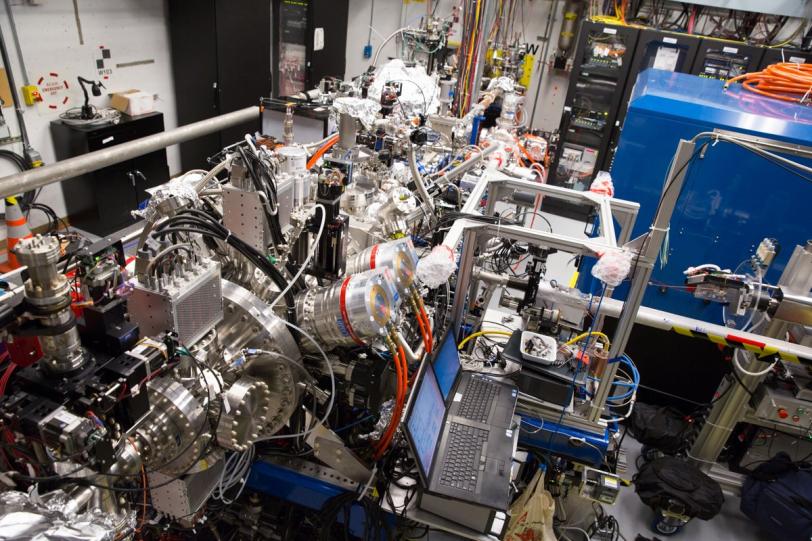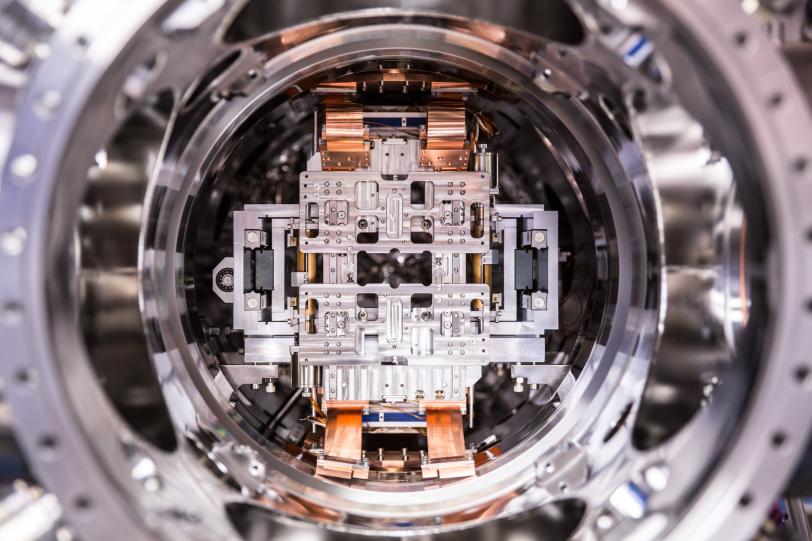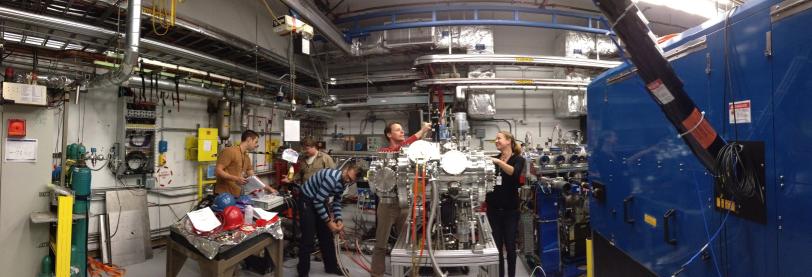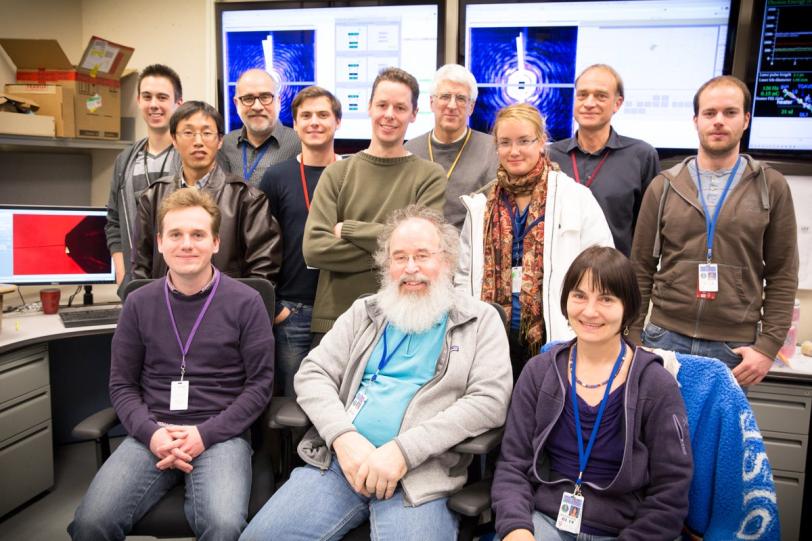LAMP: A New Tool Turns On at SLAC's X-ray Laser
A 2-ton instrument the size of a compact car, now available at SLAC's X-ray laser, makes it possible to capture more detailed images of atoms, molecules, nanoscale features of solids, and individual particles such as viruses and airborne soot.
By Glenn Roberts Jr.
A 2-ton instrument the size of a compact car, now available at SLAC's X-ray laser, makes it possible to capture more detailed images of atoms, molecules, nanoscale features of solids, and individual particles such as viruses and airborne soot.
Called LAMP, the new tool at the Linac Coherent Light Source (LCLS) also allows researchers to explore the interaction of light and matter with extreme precision and greater flexibility than possible before. Samples of liquids, solids and gases can be examined with LAMP's ultrasensitive X-ray cameras and detectors.
"There is an almost 10-fold increase in X-ray power density at the sample compared to previous imaging experiments using X-rays in this energy range, which is important for experiments looking at imaging of single particles," said Christoph Bostedt, a senior staff scientist at LCLS who led SLAC's work on the instrument. "We expect LAMP to be in high demand."
LAMP houses imaging spectrometers for electrons and ions and two megapixel pnCCD detectors for detecting individual photons of X-ray light, which were built at the Semiconductor Laboratory of the Max Planck Society.
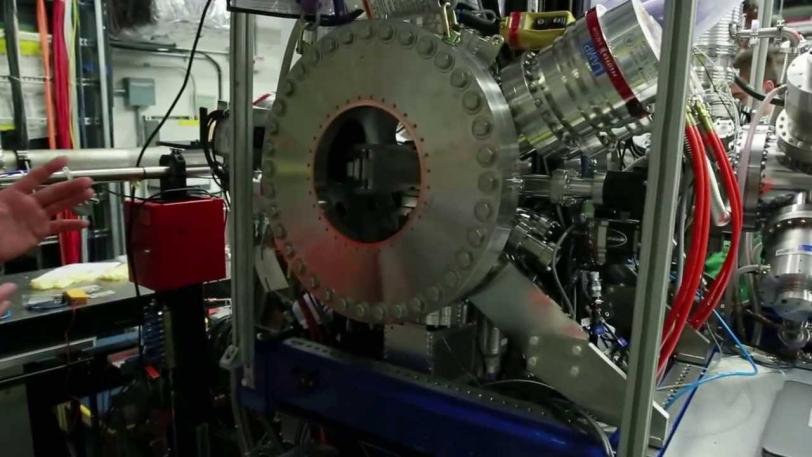
AMO | Turning on LAMP
"It's user-friendly," said Nora Berrah of the University of Connecticut, who led the collaborative project with Bostedt. "You can change your samples much faster.” Berrah worked to secure funding for LAMP and contributed to the design and construction of the instrument while at Western Michigan University.
The ability to quickly swap samples during experiments makes better use of time at the X-ray laser, which is in high demand – only about 1 in 5 proposals to conduct experiments at LCLS can be approved. With laser pulses arriving at a rate of 120 per second, every second counts.
From the stand it rests on to its central chambers, LAMP is designed to be portable, easily reconfigured and easy to dock with other detectors and instruments, said Timur Osipov, a research scientist in Berrah’s group who has worked with the SLAC team for several years and made key contributions to the project.
The entire LAMP instrument or its individual components can be moved from its current location at the Atomic, Molecular and Optical Science (AMO) experimental station at LCLS to other stations, and the design makes it easier to position detectors within the LAMP chamber to optimize their performance. “The ability to use the LAMP detectors and modules across the facility has always been high on our priority list,” Bostedt said.
LAMP is a valuable tool for exploring the fundamentals of how light and matter interact, such as how electrons travel through molecules, Berrah said. "Understanding how the energy flows in a system is fundamental to everything – physical science, chemistry and biology," she said.
LAMP is a successor to CAMP, which was essential to the first experiments at LCLS in 2009 and enjoyed heavy use until it was shipped back to Germany last year for installation at another X-ray laser.
Ilme Schlichting, director of the Max-Planck Institute for Medical Research in Germany, who participated in the commissioning of the CAMP instrument and in its early experiments, led the first experiment at the LAMP instrument in mid-December and said the instrument performed very well during its commissioning run. Several more experiments are scheduled to use LAMP over the next few months.
Describing the first CAMP measurements in 2009, Schlichting said, "It was like buying your first car – an adventure loaded with surprises. With LAMP, we were recording useful experimental data within the first shift. The detectors were behaving very well. There were absolutely no surprises. The scientific community is very excited that LAMP is here."
Built through a collaboration between SLAC's LCLS and Western Michigan University, with key contributions from Jean-Charles Castagna and Sebastian Carron of SLAC, LAMP was funded by a Department of Energy grant to Western Michigan University and developed in consultation with the Max Planck Advanced Study Group in Hamburg, Germany.
Contact
For questions or comments, contact the SLAC Office of Communications at communications@slac.stanford.edu.
SLAC is a multi-program laboratory exploring frontier questions in photon science, astrophysics, particle physics and accelerator research. Located in Menlo Park, California, SLAC is operated by Stanford University for the U.S. Department of Energy Office of Science. To learn more, please visit www.slac.stanford.edu.
SLAC's LCLS is the world's most powerful X-ray free-electron laser. A DOE Office of Science national user facility, its highly focused beam shines a billion times brighter than previous X-ray sources to shed light on fundamental processes of chemistry, materials and energy science, technology and life itself. For more information, visit lcls.slac.stanford.edu.
DOE’s Office of Science is the single largest supporter of basic research in the physical sciences in the United States, and is working to address some of the most pressing challenges of our time. For more information, please visit science.energy.gov.
